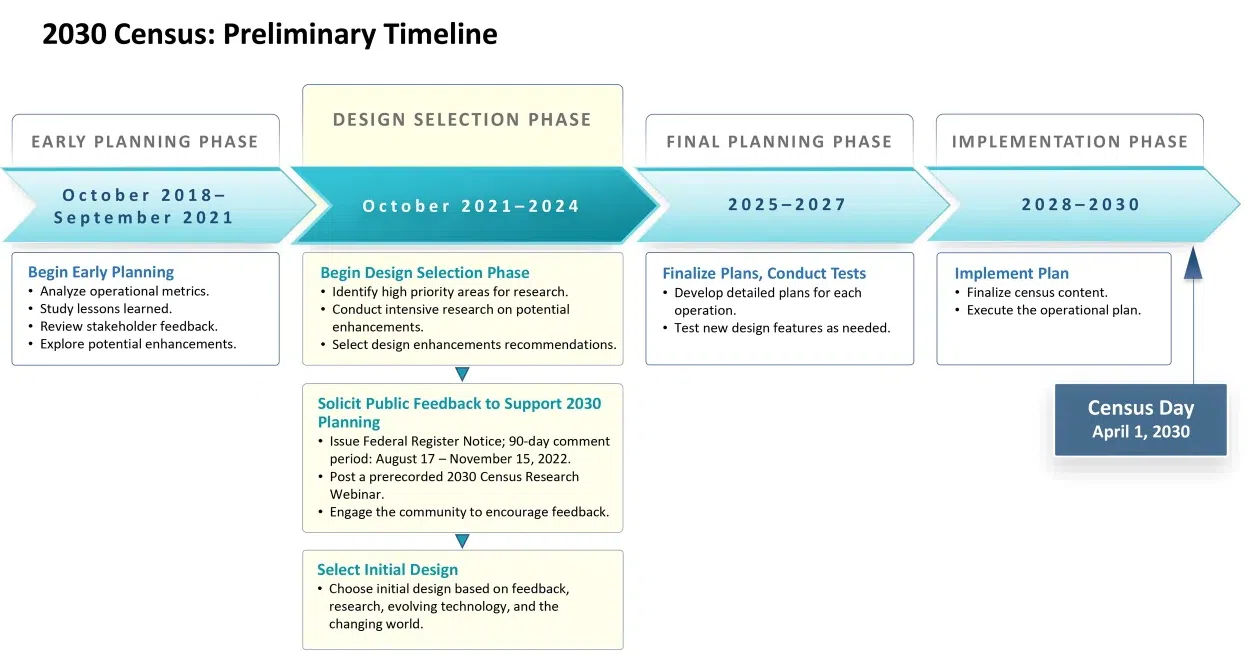The U.S. Census Bureau invites the public to share their input and ideas for an improved 2030 Census.
The Census Bureau is in the early stages of planning for the next census – a process that includes years of research and testing to prepare for the complex task of counting every person living in the United States each decade. By mid-decade, in 2024, the Census Bureau expects to decide the initial operational design for the 2030 Census – the “big picture” plan for the census. That milestone is followed by refining procedures and putting technology and other infrastructure in place for the national count in 2030.
As part of the planning efforts, the public is invited to share feedback on how the Census Bureau can improve the public’s experience during the 2030 Census. With this input, the Census Bureau aims to better reach and count historically undercounted people, overcome challenges and encourage everyone to respond to the 2030 Census. Public input is needed now so it can inform the Census Bureau’s decisions on the initial operational design, along with the findings of dozens of research projects underway.
Through the Federal Register Notice, the Census Bureau is looking for recommendations on:
- Reaching and motivating everyone. Everybody counts in the census. The Census Bureau is committed to addressing challenges that may have contributed in the past to the recurring undercount of several groups. These include the Hispanic or Latino population, the Black or African American population, the American Indian or Alaska Native population living on a reservation, people who reported being of some other race, and young children. With the public’s assistance, the Census Bureau aims to better understand how to reverse this trend, more effectively reach these populations and motivate everyone to respond to the 2030 Census.
- Technology. The Census Bureau seeks input on what technological advancements could make responding to the census more user-friendly, increase the percentage of people who respond on their own and facilitate collecting data in person when necessary.
- New data sources. For the 2030 Census, the Census Bureau is looking to use high-quality, alternative data sources wherever possible. Combined with traditional methods, the Census Bureau aims to reduce public burden while continuing to produce high-quality data products. The Census Bureau is interested in learning about new data sources, and methods of using them, that could improve data quality for the 2030 Census and increase operational efficiency and effectiveness.
- Contacting the public. Plans for the 2030 Census must include tailored contact strategies that maximize the number of households responding on their own. The Census Bureau is seeking recommendations about tools and messages to use in inviting people to respond and asks for help defining how often to reach out to each household.
- Providing support to the public. The Census Bureau asks for input on how to support people as they respond – whether online, by phone, by mail, in English or in another language – and how to improve access for people with disabilities.
For reference, the 2020 Census Operational Plan and Detailed Operational Plans provide information about how the Census Bureau designed and implemented the 2020 Census.
The Census Bureau will consider the public’s feedback along with lessons learned from the 2020 Census.
How to Provide Feedback
The public can submit comments in two ways:
- Email comments to <DCMD.2030.Research@census.gov>.
- Submit comments online through the Federal Register Notice linked from the 2030 Census webpage.
Comments must be received by November 15, 2022. Comments should be specific, detailed, clear and identify which topic(s) each comment addresses.
The Census Bureau will summarize and share the input received publicly. While the Census Bureau may not be able to implement all recommendations received, each idea and recommendation received will be given careful consideration as the agency researches, tests and plans the 2030 Census operational design.

Infographic credit US Census Bureau.







Comments